Sogdian Dahai and the Formation of the Arsacid State
Scientific Proceedings of Vanadzor State University Humanitarian and Social Sciences (ISSN 2738-2915)
2023 vol 1
Sogdian Dahai and the Formation of the Arsacid State
Artur Melikyan
Summary
 Key words: the Aparns, the Xanthi, the Pissurs, the Achaemenids, Parthia, Soghdiana, Bactria, Strabo, Arshak I, Diodotos I, Evtidemos I
Key words: the Aparns, the Xanthi, the Pissurs, the Achaemenids, Parthia, Soghdiana, Bactria, Strabo, Arshak I, Diodotos I, Evtidemos I
At the beginning of 4th century BC, the Dahai tribes of the Xanthi and Pissurs were ousted from the steppes of left bank of Amu Darya’s delta by newly independent Khorezm. They received from the Achaemenid king Artaxerxes II a new migration area in Soghdiana, in the Zeravshan basin. As a result of this resettlement, the three-tribal union of Dahai practically split into two parts. Their traditional connections and centralized control system were broken. The Sogdian Dahai adapted to the satrapy administration of Bactria and remained loyal to the Achaemenid dynasty until the end. However, in 327 BC, after the establishment of Macedonian rule in Soghd, their condition began to deteriorate. The policy of tight control over the nomads by the Macedonian administration of the “Upper satrapies” changed the previously normal and mutually beneficial coexistence of the nomadic and settled population of the oases into hostile relations. The condition of the Sogdian Dahai especially deteriorated during the reign of the Bactrian king Diodotos I, and after the reign of Evtidemos I (225 BC) it became hopeless. An important impetus for their migration to the eastern shores of the Amu Darya was the call for help from King Arshak I, the leader of the Apars tribe. After the first unsuccessful attempt to conquer Parthia, the latter faced the task of expanding its social base, which, in fact, he could only do by resettling kindred Dahai tribes.
The resettlement of the Sogdian Dahai, or, as Justinian calls them, “the ones expelled from Scythia” to the “country opposite to Areia” began gradually, and most of them settled here after 217 BC, the period when Arshak I conquered Parthia for the second time. After more than a century of separation, the two parts of the Dahai Union reunited again, but in new administrative and political realities, under the royal rule of Arshak I, the leader of the Apars. The immigration of the Xanthi and the Pissurs sharply increased the military potential of Arshak I, due to which he not only conquered Hyrcania in a short time, but also opposed the Greco-Bactrian kingdom. On the other hand, participation in the Arsacid State formation and the Dahai’s dominance preservation over the population of Parthia and Hyrcania, provided the tribal lider clans of Xanthi and the Pissurs with the right and opportunity to claim a high position in the newly created socio-political system of the Arsacid State.
